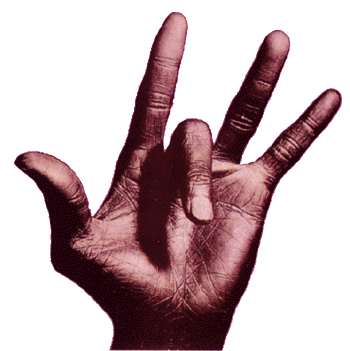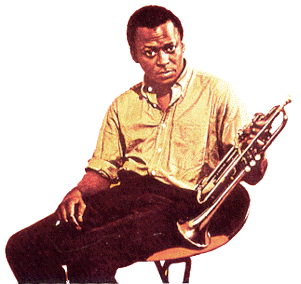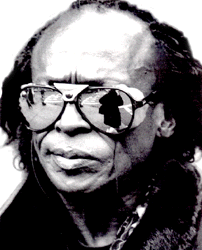MILES DAVIS

Perhaps the greatest jazz musician of the 20th century, Miles Davis, was born to Miles and Cleota Henery Davis in 1926. At the time of the musician's birth, the family was living in Alton, Illinois, but in 1927, they relocated to East St. Louis, Missouri.
Miles Davis is so important to jazz because of his ability to continually evolve. This evolution resulted in a continuous impact on the world of jazz that saw Miles move from bebop to helping found cool jazz, hard bop, third stream music, and fusion jazz, as well as staying in the avant-garde of jazz music for much of his career. His innovations forever changed jazz, and although a great trumpet player, he is most remembered for his stylistic innovations.
Miles got his first trumpet as a gift from his father, a wealthy dentist, in 1939, when he was thirteen. He went on to play with his high school band as well as playing with Eddie Randall's Blue Devils band while still in school.
1944 was a very influential year in the budding career of Miles Davis. He had the opportunity to hear the Billy Ekstine Orchestra when it held a concert in St. Louis. Davis was extremely taken with the musical prowess of Charlie Parker and Dizzy Gillespie, both members of the orchestra.
But before Davis could completely involve himself in the jazz world, he went to study music at the Juilliard School of Music when he was 18. It was still 1944 when Miles began his studies, however, by 1945 he had dropped out. He clearly felt a stronger calling from the jazz scene on 52nd Street in New York, and spent most of his time in the jazz clubs rather than going to class. He made his first recording in 1945 accompanied by Rubberlegs Williams, a singer. By the end of the year, Davis was playing on a regular basis with Charlie Parker.
Miles was so enthralled with Parker that he followed him out to California where he recorded with Parker and joined his quintet. By 1948 Davis had returned to New York and created his first group, the Birth of The Cool Nonet. Davis was working with arrangers such as Gil Evans, John Lewis (of the Modern Jazz Quartet) and Gerry Mulligan on the material he produced during this time.
 Davis's
life began to take a turn for the worse by 1949 when he became addicted to
heroin. Fortunately, the group he was working with at the time
(1951-1954); Jimmy Heath, J.J. Johnson, Horace Silver, Art Blakey and
Sonny Rollins, helped him to create a style that greatly contributed to
what would become hard bop.
Sadly, Davis's addiction hindered the band and they only performed
sporadically during this dark time.
Davis's
life began to take a turn for the worse by 1949 when he became addicted to
heroin. Fortunately, the group he was working with at the time
(1951-1954); Jimmy Heath, J.J. Johnson, Horace Silver, Art Blakey and
Sonny Rollins, helped him to create a style that greatly contributed to
what would become hard bop.
Sadly, Davis's addiction hindered the band and they only performed
sporadically during this dark time.
Luckily, Davis was able to free himself from his heroin problem later in 1954 and make a come-back that would achieve great success in 1955. This was the quintessential year that would produce the classic "Round Midnight" that was first performed at the Newport Jazz Festival. It was during this time that Davis formed another quintet that included John Coltrane, Paul Chambers, Philly Joe Jones and Red Garland.
This group recorded a total of five albums in 1955 and 1956. Four albums were on the Prestige label while "Round Midnight" was produced by Columbia. Miles Davis became a jazz hit as a result of these albums and even the breakup of the band in 1957 did not slow him down.
In 1958 he formed perhaps his most acclaimed band with Cannonball Adderly, John Coltrane, Bill Evans, and Philly Joe Jones. Jones and Evans were ultimately replaced by Jimmy Cobb and Wynton Kelly. Davis, with his band, produced the albums "Milestones" and "Kind of Blue" that introduced modal improvising to jazz. These albums are seen by many as the high point in the development of cool jazz, which was Miles' (and others) reaction to bebop and hard bop.
Cool jazz was far more intellectual, more understated, and with more complex written arrangements than bebop or hard bop. "All Blues" from 1958 is a fine example of cool jazz and shows Miles' group at its best with Miles on the trumpet and John Coltrane on the tenor sax. This excerpt is from the album, "Kind of Blue," which is considered one of the greatest jazz albums of all time.
Miles was once again recording with arranger Gil Evans and they together produced the albums "Miles Ahead" in 1957, "Porgy and Bess" in 1958 and "Sketches of Spain" in 1960. On the latter two albums, Miles ventured into the playing of the flugelhorn in addition to the trumpet. Most importantly, the relationship between Evans and Davis resulted in the development of chamber jazz, or third stream music. Basing their compositions on classical works, or motifs from classical works, they created an entirely new kind of music that opened the door for the merger of jazz and classical. A good example of Chamber Jazz/third stream music comes from the album "Sketches of Spain" and is called "The Pan Piper."
 Through
the 1960's, the Miles Davis band would see many changes in its
composition. Musicians, such as saxophonist John Coltrane, would move on
to form bands of their own. The music Miles was producing at this
point was morphing into a funky jazz spiced
with soul. Davis's music was
very unique because it provided the missing link between the styles of
hard bop and free form jazz.
Through
the 1960's, the Miles Davis band would see many changes in its
composition. Musicians, such as saxophonist John Coltrane, would move on
to form bands of their own. The music Miles was producing at this
point was morphing into a funky jazz spiced
with soul. Davis's music was
very unique because it provided the missing link between the styles of
hard bop and free form jazz.
The addition of electric keyboards was introduced in the late 1960's as well as the vocals of Wayne Shorter who added soprano elements to the mix. Davis's music now possessed the feeling of rock combined with improvisational jazz. The group, now considered a fusion band, produced the albums "Bitches Brew" and "Silent Way" using a variety of instrumentals.
The large ensemble put together by Davis in 1969 to explore this new music included Davis on the trumpet, rock musician John McLaughlin on guitar, and Chick Corea, whose work spans jazz, rock and classical music, on keyboards. "Bitches Brew", a massive and difficult double album marked the beginning of fusion jazz.
This album was one of the first successful attempts to create an entirely new form of music by combining jazz solos with rock rhythms. It brought many rock fans to jazz and changed jazz forever, as young jazz musicians became involved in rock. Here is a short excerpt from the 27 minute long title song "Bitches Brew". It is important to remember that this is only a sample of a long, probing and difficult piece of music whose impact is still felt today.
While music worth listening to was still produced by Davis between 1970 and 1975, some believed that he used electronic elements too heavily, therefore distorting the sound of his horn. The tremendous promise that fusion had shown in 1969 began to diminish as more and more young jazz musicians moved to rock music.
Abruptly in 1975, Davis retired from music and was not heard from again until 1981. His trumpet playing was still quite exceptional and he continued to tour throughout the last decade of his life. In 1991, he once again worked with Gil Evans and played at the Montreux Jazz Festival. Only two months later Miles Davis died at the age of 65.
Page author: N.G.
